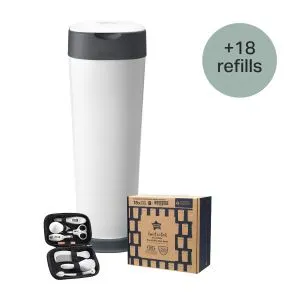
Ultimate XL Nappy Disposal Bundle with 18 Refills
Bundle & Save 40%
Subscription orders can be cancelled at anytime. Free delivery on all subsequent subscription orders. Find out more about subscriptions.
They’re easy and fuss free
Your products are automatically sent to you
You save up to 10% when you sign up for a subscription
You can cancel at any time
The Difference Between Colic & Reflux in Babies

We've written this guide to help new parents (or anyone who wants to learn more about colic and reflux in babies) understand the difference between colic and reflux.
It's important to know the difference between the two so that you can give your baby the appropriate care and treatment.
The symptoms of colic and reflux can be very similar and lots of parents struggle to identify which problem their baby is suffering from. Let's run through the key symptoms and causes of colic and reflux to help you out.
Colic is excessive crying in infancy without a known cause. Young babies can get it from around two weeks of age, and it can last until they reach six months old.
The signs and symptoms of colic include baby:
The exact cause of colic in babies isn't known, but it's thought that it may be caused by digestive upsets like a build-up of gas due to:
In some cases, it may also be caused by overstimulation. It can understandably take newborn babies time to adjust to life outside the womb.
Explore the Range
The good news is that colic doesn’t last forever, and as much as the crying can be distressing it’s very common in infants and not dangerous. Colic symptoms usually ease by the time a baby is five or six months old.
Reflux – also sometimes known as posseting or spitting up – in babies is a common condition where the contents of the stomach move back up into the oesophagus, causing uncomfortable, heartburn-like pain, and sometimes vomiting that comes out of baby's mouth or nose.
Babies usually start getting reflux before they're eight weeks old. You should see your GP if your baby gets reflux for the first time after they're six months old.
It can be difficult to distinguish between reflux and colic in babies, which is why it's important to educate yourself on the differences between the two. Your baby may have reflux if they are:
Reflux usually starts in babies who are under eight weeks old as the muscles of their oesophagus (food pipe) haven’t developed properly meaning that milk and stomach acids can travel back up.
Sometimes babies can show signs of reflux, but don’t spit out milk or visibly be sick. Instead, they swallow it. This is known as silent reflux. In cases of silent reflux, it's less obvious to parents and carers what's happening, but still painful and unpleasant for baby.
Feeding your baby in an upright position and keeping them upright for as long as possible (ideally at least one hour) after feeding means that gravity can help keep the milk down and prevent it from coming back up. If your baby is breastfed and experiencing reflux, it may help to give a different breastfeeding position a go.
Practising paced feeding, feeding your baby slowly and giving formula-fed babies smaller feeds more often if they're formula-fed helps to prevent their tummy from becoming too full.
Burping your baby regularly during and after feeds helps to release any trapped wind that may be making them uncomfortable.
You should always place your little one on their back – not their front or side – to sleep and you shouldn’t raise the head of their cot or Moses basket. As they grow, they'll start to roll from their front to their back independently, then you can leave them to find a comfortable position on their own.
Getting into the habit of recording your baby's feed and symptoms in diary form can be helpful for the doctor to review if your baby is struggling to gain weight.
The good news is that reflux doesn’t last forever, and while it can be painful to see your baby in discomfort, it usually stops by the time a baby is one year old. However, if you're worried about your baby at any stage, you shouldn’t hesitate to ask your health visitor for advice and support, and you should see your GP if your little one still has reflux after their first birthday.